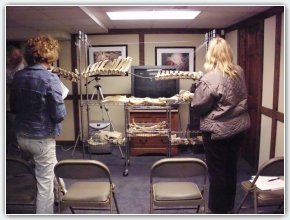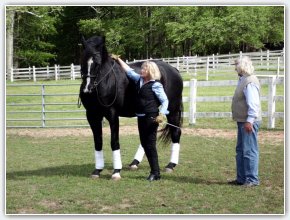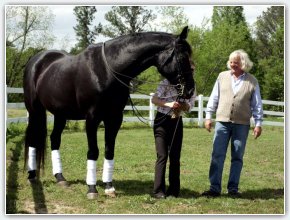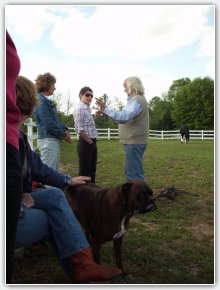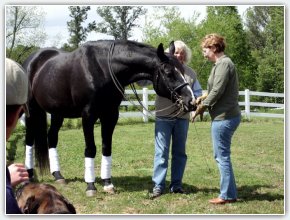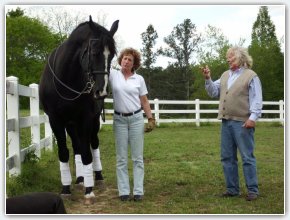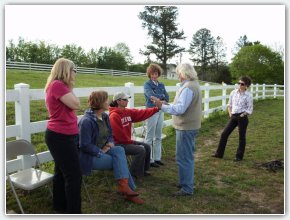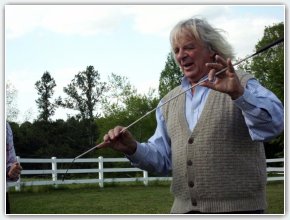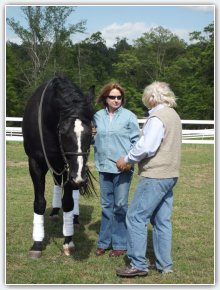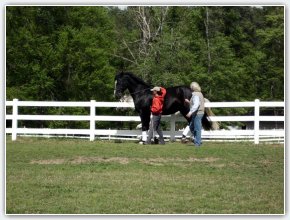Past Events
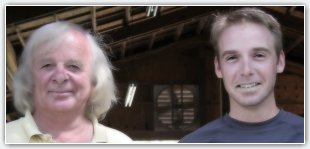
The first Immersion One to One was completed Tuesday and Wednesday, August 23 & 24. Adam Gamble was the best first student that we could have expected. A talented rider with a strong classical and European culture, he learned in Spain, England and now in the US. Adam is currently the trainer of Abbeymoor Farm in North Carolina. Adam is training and selling competition horses. One of his horses in training is the stallion Moorpark Image Rid. Adam’s website is www.abeymoorfarm.com
Adam and his mare Misty came to improve their skills. The conversation started in the barn while tacking up the horse. Adam was describing his impressions, successes and difficulties. Jean Luc was asking questions.
In the training ring, Jean Luc observed the mare, pointing out details in the gaits that suggested an imbalance between right and left transversal rotation of the mare’s thoracic spine. Jean Luc explained the phenomenon of transversal rotation and they worked together underlining the importance of the horse’s natural cadence and the condition that would allow the shoulder in to correct the mare’s back muscle imbalance.
Back in the class room, Jean Luc manipulated the vertebral column specimen and selected computer animations that clearly explained the mare’s issue. “As I was offering the first drink Adam was listening carefully. When I brought the second drink they were having a very technical but very friendly discussion. In fact, I stayed some time with them listening to their very interesting exchanges” (Helyn)
The next session in the training ring demonstrated the efficiency of the approach. Having clearly in mind the picture of the proper coordination between lateral bending and transversal rotation, Adam had greater ease in properly interpreting his mare's reaction and providing appropriate insights.
Jean Luc often refers to Vincent van Gogh’s thought, “I dream my painting and then I paint my dream.” Having in mind the right picture, (I dream my painting), Adam had greater facilities to lead his mare toward the proper coordination, (and then I paint my dream).
Immersion 1 April 16th 2011

Immersion I was a great success
A very successful first immersion program, (Immersion I), set the stage for a new approach to the practical application of advanced equine research studies, friendly, comfortable and educative. In the attendance was Mary Linda Rapelye coming from Maine, Diana Skiviel coming from California, Tami Parr coming from Wisconsin, Rosemary Crowley coming form Pennsylvania, Sarah Gansthoude coming form Colorado, Lori Araki coming from North Carolina and Betsy Uhl, coming from Georgia. They came from far away because they new that they would receive information that they could not find anywhere else, and they did.
Upon arrival they received an instructional package composed of text explaining the subject of the workshop, A second text explained a lunging technique know as Decarpentry 2nd manner. A DVD showing the practical application of the lunging technique and a visual document distinguishing correct movement from abnormal locomotion was also part of the package.
The introductory document entitled Mechano-responsiveness emphasized how proper exercise enhances all aspects of the horse’s metabolism. The concept that living organisms are constructed from tiers of systems within a system within a system was emphasized. For instance, a limb is composed of bones, muscles, blood vessels, nerves, etc. These in turn, are constructed from muscle fibers, vascular endothelium, and connective tissues. Riding principles and training techniques might give results at one scale level and damage the horse’s physique at a deeper scale level. For instance bending the neck laterally might achieve some lateral bending at a superficial level but induces inverted rotation which in turn will damage vertebral column structures at a deeper level.
Since the horse is primarily a creature of motion, the purity of the horse’s gaits is the sole authentic reference. Underlining the fact that when it came to proper gaits and forward movement, judging standards are not a valuable reference, a video was played showing Olympic horses recorded during the Atlanta dressage Olympic and demonstrating kinematic abnormalities and excruciated pain during the execution of the piaff. The video ended with a more recent recording where an extraordinarily talented horse was showing the damages of conventional training techniques as well as the incongruity of judging standards, leaping on three legs in the dressage ring and rewarded with a score of 68.9%
The demonstration went on educating the eye to distinguish proper movement and how to lead the horse’s brain to soundness and excellence. The demonstration started at the lunge line and ended with an in hand presentation. Back in the class room, a horse’s vertebral column suspended in the air was used to explain how the horse’s vertebral column mechanism converts the thrust generated by the hind legs into balance control.
After lunch each participant had the great opportunity to practice the work in hand and experiencing the extraordinary feeling of a horse adjusting the coordination of his vertebral column’s muscles in response in nuances in muscle tone of the rider’s back muscles. Manchester is a 18,2 hands Hannoverian and his kindness and responsiveness seduced each participant. Both, Chazot and Manchester, who are well known from everyone following their conversations (see Chazot Thought in our website,) participated in the workshop showing that they were indeed the characters described in the Chazot Thoughts’ series.
The hand on practice amazed each participant. It is one thing to state that the horse does have the sensitivity to perceive adjustments of the rider’s back and abdominal muscles even when the rider is walking next to the horse. It is another thing to experience it in real life.
Since most of the attendants were massage therapists and veterinarians, the discussion focused on the importance to follow appropriated therapies with riding and training techniques educating the horse’s physique properly. The same symposium could greatly help riders and trainers understanding how to create a functional athlete and therefore a horse performing at the best of his or her talent and remaining sound.
Jean Luc and Helyn Cornille
Science Of Motion
www.scienceofmotion.com
Immersion Two
A Special Place for a Special Education
Jean Luc Cornille
Snellville Georgia
Event has passed
There is a lot more into the work in hand than just walking next to the horse. The feeling of a horse adjusting the work of his back muscles to the tone of the handler’s back muscles is fascinating. This is the first step, or maybe it would be more appropriate to say, the first steps of a deep (r)evolution. For riders and trainers these first steps are initiating the evolution from dog training such as seen with typical dog training, (obedience to the rider’s aids), to athletic training, (preparing efficiently the horse’s physique for the effort). For the therapist, the experience opens a new era in the capacity of reeducation; placing the therapies in motion.
In response to popular demand, Immersion Two Is a three day event.
Friday June 10, Saturday June 11, Sunday June 12, 2011. The weekend is set-up to introduce the work in hand to therapists, riders and trainers as well as in furthering their knowledge and practical application of this work in hand. June 10 is a repeat of Immersion One. June 11 is a pertinent analysis of the horse’s locomotion. A video animation educates one in distinguishing and understanding the braking and pushing phase of the hind and front legs. Sunday 12, the work in hand intermediary level, teaches how to further the horse’s collection and introduces the practice of shoulder in and half pass.
One can come for one day or two or three.
The trademark of the Immersion program is to provide the knowledge that supports efficient practical application. Friendly, casual, informative and always with humor, the week end of June 10, 11,and 12 is set to be an even greater success than Immersion One.
The Science of Motion’s Certification program is going to be based on credits gained through Videos, clinics, books and Immersion programs. Each day provides credits toward the qualification.
Friday June 10
Lunging with tradition
Decarpentry Second Manner.
Emphasis is made on the horse’s natural cadence, proper
mechanism of the horse’s vertebral column and spontaneous
and efficient placement of the horse’s neck. The technique
allows the addition of straight lines in order to diminish the side-
effects of lunging.
Work in Hand
The science of motion approach.
Introduction to the work in hand. Hands on practice with Manchester.
Video; One Hand on his Shoulders.
Discussion; How the horse’s vertebral column really functions
Working documents; Mechanico-Responsiveness, (text). Lunging with Decarpentry, (text and DVD).
Saturday June 11
Forward
In order to win in the jumping ring as well as the dressage ring, one needs to go fast. The purpose of this Immersion session is to assess the mechanical overloads induced on the front and hind limbs as well as vertebral column by the demands of modern competitions, and how to efficiently prepare the horse’s muscular system for these demands.
Classic authors have always warned, “Do not confuse speed with impulsion.” Modern dressage promotes intense forward motion, which is technically speed. Both parties deeply believe that they profess the true and both parties use expressions such as thoroughness through the back, carrying weight on the haunches, without understanding underlying biomechanics factors. At the contrary, scientific measurements demonstrate that balance is not achieved with the hind legs carrying more weight but instead increasing the duration of their support phase. Also, the greatest amount of upward propulsive force is not produced by the hind legs, but instead by the forelegs. “In horses, and most other mammalian quadrupeds, 57% of the vertical impulse is applied through the thoracic limbs, and only 43% through the hind limbs.” (H. W. Merkens, H. C. Schamhardt,G. J. van Osch, A. J. van den Bogert, 1993).
These concepts are difficult to understand and even accept in the line of conventional thinking. Instead, these concepts became obvious when riding principles and training techniques are analyzed in respect to the advanced knowledge of the equine physiology.
“Forward” is a journey, literally, where forward movement is analyzed in light of pertinent scientific discoveries; how hind and front limbs produce forward motion. How the horse’s vertebral column converts the thrust generated by the hind legs into forward movement and balance control, how to define speed, what is the biomechanics of impulsion, etc.
On one side of the camera, there is a horse and a man who show the differences between forward movement and fast forward motion. On the other side of the camera there is a woman who’s artistic sense and mastery of computer technology transforms, through slow motion and subtle animations, a life demonstration into a superb education. What you are about to see during this journey has never been showed before. You will end the day with a perspective updated to actual knowledge. Your journey with your horse will no longer be performing until lameness. Instead your journey will be about furthering soundness through better performances.
Sunday June 12
Work in Hand
Intermediary Level
There is much more to the work in hand than just walking next to the horse.
The first step is to experience the extraordinary feeling of a horse adjusting the work of his back muscles to the tone of the handler’s back muscles.
The next step is to work the horse. In this Intermediary level, you will
learn - How to further the horse’s collection,
- Introduction to the shoulder in
- Introduction to the half pass
The discussions will explain Collection, Shoulder In and Half Pass in light of the most advanced knowledge of physiology
Immersion Three (this event has past)
A Special Place for a Special Education
Jean Luc Cornille
Snellville Georgia
Friday July 22, Saturday July 23, Sunday July 24, 2011.
One can come for one day or two or three.
The trademark of the Immersion program is to provide the knowledge that supports efficient practical application. Friendly, casual, informative and always with humor.
The Science of Motion’s Certification program is going to be based on credits gained through Videos, clinics, books and Immersion programs. Each day provides credits toward the qualification.
Kissing Spine
Jean Luc Cornille 2011
Kissing spine is unfortunately a relatively frequent problem with very few medical solutions. One is invasive surgery, with all the risks related to surgery. The other is injections which might provide transient relief but do not cure the problem nor teach the horse to live with the abnormality.
The problem of kissing spine often combines genetic anomaly and protective posture. The dorsal spines are inherently too close and the horse adopts a protective posture providing short-term relief but long-term problems. In a 1980, Leo Jeffcot summarized the results of 443 cases of horses having back issues. The British scientist categorized the severity of dorsal spine impingements into five levels.
Interestingly, there were a high percentage of affected horses showing a higher level of severity, (42%). In the eighties, back soreness was thought only to be a compensation for hock pain or other musculoskeletal disorders. Commonly, kissing spine issues induce discomfort in the hind legs. The symptoms vary from reluctance to pick up the hind legs to lameness. One can imagine that with the mind set on the thought that back problems were the outcome of hock issues, hocks and other limb joints were investigated and injected again and again before looking higher into the horse’s vertebral column. When finally the focus was directed on the horse’s back, the problem had already evolved to the higher severity level.

With technology improving the quality of the pictures and a greater willingness to investigate the horse’s vertebral column, horses can be diagnosed even when the dorsal spine only touches intermittently. These horses are easier to reeducate. The concept of therapy in motion is pertinent especially in a world where training techniques are the main cause of equine injuries. In 1994, Mikael Holmström wrote, “Most dressage manuals describe the training of passage and piaff, but very few explain how the horses perform them.” Indeed, the science of motion focuses precisely on the body coordination allowing a horse to perform soundly and efficiently.
In many instances, the genetic predisposition, which places the dorsal spine too close, does not alter the horse’s activities until the intensity of the demand increases or the horse is submitted to inappropriate training techniques. Very little can be done about this genetic predisposition, which places the dorsal spines a little too close, but a horse can learn to work and function efficiently with this genetic abnormality. The key is to identify the posture and working attitude causing intermittent contact of the dorsal spines. The horses that we have reeducated presented a combination of stiffening or arching of the thoracolumbar spine, associated with a problem of lateral bending and/or transversal rotation.
Once the source of the kinematic abnormality has been identified, the reeducation is in fact an education. The therapy for kissing spine can be summarized as educating the horse to live with his problem. The horse learns to function efficiently adopting a vertebral coordination avoiding closing of the dorsal spines.
Adequate gymnastics is in fact the horse’s sole hope. The reeducation is precise, demands great consistency, but is not outrageously difficult. In fact, the difficulty is more in turning back to old habits.
“A man should look for what is, and not for what he thinks should be.” (Albert Einstein) The horse’s thoracolumbar spine can be reeducated addressing the horse’s thoracolumbar column as it really works and not how conventional equitation thinks it should work. The same can be said about dressage movements. For instance, shoulder in has been abundantly used in the reeducation of horses presenting impingements of the dorsal spines. However, the shoulder in rewarded in the show ring is not by any means the gymnastic exercise used for the reeducation of affected horses. Judges reward a shoulder in executed with a lateral bending of the neck exceeding the lateral bending of the thoracic spine. Practiced this way, the shoulder in does not have the educative effects that were the pride of its inventor. “This lesson produces so many good results at once that I regard it as the first and the last of all those which are given to the horse in order to make him develop complete suppleness and perfect freedom in all part of his body.” (Francois Robichon de la Gueriniere, Ecole de cavalerie, 1731).
Lateral bending of the neck that exceedes lateral bending of the thoracic spine is likely to induce inverted rotation of the thoracic vertebrae. Such inverted rotation is placing the pelvis in the wrong inclination. The inside hip joint is then higher than the outside hip joint rendering it difficult for the horse to lower the inside haunch, which is the main value of the shoulder in.
Lateral bending of the horse’s vertebral column is always coupled with a movement of transversal rotation. The proper combination, which is illustrated on the right side of this picture, (correct rotation), predisposes the horse’s physique for the right shoulder in. “The shoulder-in prepares a horse for placing his weight on his haunches because, with each step that he takes in this posture, he brings the inside hind leg forward under the belly and places it over the outside hind leg, which he cannot do without lowering the haunch.” By contrast, the incorrect combination, which is illustrated on the left side of this picture (inverted rotation), places the dorsal spines and the pelvis in a postural alignment inappropriate for the movement.
The proper combination, which is illustrated on the right side of this picture, (correct rotation), predisposes the horse’s physique for the right shoulder in. “The shoulder-in prepares a horse for placing his weight on his haunches because, with each step that he takes in this posture, he brings the inside hind leg forward under the belly and places it over the outside hind leg, which he cannot do without lowering the haunch.” By contrast, the incorrect combination, which is illustrated on the left side of this picture (inverted rotation), places the dorsal spines and the pelvis in a postural alignment inappropriate for the movement.
The association between lateral bending and transversal rotation was comprehensively explained in 1999, which is more than two and half centuries after Monsieur de la Gueriniere (1688-1751). The findings underline the fact that only a horse associating lateral bending and correct rotation is physically coordinated for the real shoulder in. At the contrary, the shoulder in executed with a bending of the neck exceeding the bending of the thoracic spine is creating inverted rotation downgrading the movement into a useless contortion. No need to say that the shoulder in used for the reeducation of horses affected with impingement of the dorsal spines is the real shoulder in.
“I dream my painting and then I paint my dream.” (Vincent van Gogh, 1853-1890) As well, the horse’s education and never the less the horse’s reeducation, demands a sound vision of the horse’s locomotor apparatus (I dream my painting) and an equitation refined to the subtlety of the horse’s biological mechanism, (and then I paint my dream). Everyone wants a gymnastic exercise or postural alignment that would fix the problem. There are event pretenders selling miraculous postures or rein effects. The reality is that there is not any movement having any specific effect as long as the rider does not have a sound understanding of the horse’s biological mechanism. For example, lateral bending of the horse’s thoracolumbar spine demands knowledge and sound understanding of the interactions between lateral bending and transversal rotations.
Four cases of kissing spine were presented on the second day of the third Immersion Program. All four horses regained soundness and propensity to perform. However, one of the four horses, which was a powerful mare, did not return to performances. This was not because her physique was impaired but because her memory was badly bruised by previous experiences. The powerful mare was sound and performing well on the flat but the sole presence of jumps in the ring triggered frantic panic. Before being diagnosed with kissing spine the mare’s reluctance to perform had been interpreted as bad behavior and she was aggressively ridden on jumping courses.
The reeducation of Cocoa, which was one of the four horses suffering impingement of the dorsal spines, has been documented with almost daily video recording. The document demonstrates that while dressage movements are an intricate part of the horse’s reeducation, success does not rely on a specific gymnastic exercise but rather on daily analysis of the horse’s evolution. Living mostly in the moment, the horse does not develop protective reflex mechanisms for a better future but instead for instant relief. Sometimes the horse’s mind is following a logic that does not fit human thinking. Success demands an understanding and respect of the horse’s thought process; guiding the horse’s brain toward more appropriate body coordination.
success does not rely on a specific gymnastic exercise but rather on daily analysis of the horse’s evolution. Living mostly in the moment, the horse does not develop protective reflex mechanisms for a better future but instead for instant relief. Sometimes the horse’s mind is following a logic that does not fit human thinking. Success demands an understanding and respect of the horse’s thought process; guiding the horse’s brain toward more appropriate body coordination.
While the combination of back rigidity and spastic scoliosis kept the thoracic spine chronically bent to the left, which was the postural alignment causing impingement of the dorsal spine, the problem that initiated Cocoa’s wariness was his incapacity to properly use the propulsive activity of the forelegs. The horse was controlling balance by opposing the braking activity of the forelegs to the propulsive activity of the hind legs. It is in fact very probable that this opposition of force was the root cause of the postural misalignment causing the kissing spine issue. Cocoa becomes sound in about two weeks, but exhibited very short movement of the forelegs. It took 40 days for him to figure out how to properly coordinate the propulsive activity of both, the hind and front legs.
Several approaches have been used to guide his mind toward the right coordination. Once Coca figured out how to properly coordinate the propulsive activity of the hind and front legs, the progress went very fast. Coca was fully reeducated and ready to go home in three months.
Kissing spine often sounds like a death sentence. In fact, in most instances, the problem is not even difficult to resolve. The reason for somber prognosis is that standing therapies are powerless. The solution is to create new and adequate locomotor patterns, which can only be done with the horse in motion. Basically, competent equitation is the horse’s best therapy. James Crook wrote, “A man who wants to lead the orchestra must turn his back on the crowed.” The form of equitation that is crippling the horse perpetuates the heretical beliefs that the horse’s vertebral column can be stretched and that its range of motion can be increased. By contrast, an equitation upgraded to actual knowledge of the equine physiology regards the mechanism of the equine vertebral column as a large orchestra where multiple instruments tune up their part with great subtlety to every other instrument creating an overall harmony.
Another metaphor distinguishing equitation that cripples the horse from equitation that reeducates the horse comes from Albert Einstein, “As our circle of knowledge expands, so does the circumference of darkness surrounding it.” The circumference of darkness emphasizes a rigid order to which the equestrian education is submitting the horse, forward before balance, balance before straightness and so on. These training principles are both archaic and ineffective. Any living creature is composed of systems within systems within systems. All systems have to work in harmony. Any action executed at one level will not have the expected effect if the deeper systems are not properly coordinated. Lateral bending for instance will not have the expected effect if not associated with the correct rotation.
One just has to place, in parallel, a commonly accepted principle of conventional equitation; correct aids equal correct movement with a basic understanding of the horse’s neurological system, to measure the thickness of the darkness. “Various networks at different levels of the nervous system coordinate different motor patterns, be they the eye or hand movements or those that underlie respiration, locomotion and posture. Together, these networks provide a motor infrastructure that can be used by the nervous system to generate the elegant movements of a ballet dancer or the demanding postural control of a tight-rope walker. Some networks are present at birth, whereas, others mature during development to be modified and perfected through learning.” (Sten Grillner, The motor infrastructure: from ion channels to neuronal networks. Nature reviews/ neuroscience. Volume 4, July 2003). This motor infrastructure permits the whole to learn new patterns of coordination. However the components of this infrastructure, which are referred to as central pattern generators, have their own capacity of learning. Applying the so-called correct aids, the rider stimulates a series of complex networks. The quality of the performance relies on the proper orchestration of these many networks instead of the accuracy of the rider’s aids.
Whatever the correctness of the rider’s aids, the shoulder in will never be a real shoulder in as long as the rider does not have knowledge, understanding and feeling of the difference between proper and inverted rotation. In fact, the multiplicity of the many layers involved, clearly expose that the rider only influences the visible part of the iceberg. What we can consider as the body of the performance is the sound coordination of the whole network. Since a great part is not under direct control of the horse’s cortical decision, the whole concept of submission and obedience is in the surrounding darkness.
If not submitted to a system, the horse’s nature is the rider’s best help. From superficial to macroscopic level, the horse’s biological system is designed and functions in search of efficiency, which for the horse is about minimum muscular work and maximum force production. Through subtle body language, the rider’s job is guiding the horse’s brain toward the most efficient coordination. Given a chance, the horse willingly participates to the research. Equine athlete efficiency coordinate is performing easily. Ease is the rider’s best information. If the horse performs easily, his physique is adequately coordinated for the effort. At the contrary, if the horse struggles, his physique is improperly coordinated. When one comes back from a training session feeling pain in the back and shoulders from having pushed the horse intensively and supported heavy weight on the hands, one needs to reflect on the training technique. A horse efficiently coordinated performs easily.
Out of their talent, dysfunctional athletes might win in the show ring but only until the hocks collapse or the dorsal spine inherently too close starts to contact intermittently. The reeducation of kissing spine, like the reeducation of navicular syndrome and other injuries, is about creating a functional athlete. In fact the morning of the second day, which was focusing on the kissing spine issue, a horse was brought to the center for navicular syndrome. The participants of Immersion III were invited into the ring and assited and even participated in the analysis. Unfortunately, the horse was brought to the Science of Motion too late. The horse had already been nerved twice. The gait abnormality was not the one that caused navicular syndrome in the first place. Instead, the forelegs’ kinematics was adapted to the discomfort created by the advanced stage of the disease. However, even at this advanced level, it was possible to create a locomotor pattern providing some relief. The work was done in hand. The horse was very willing and obviously quite intelligent. Working on the biomechanics of the vertebral column it was possible to reduce the weight loading of the forelegs and the horse showed noticeable difference in his walk. In spite of being new in the work in hand, the horse’s owner was capable in improving the horse’s balance providing greater comfort in the alighting and support phase of the forelegs.
The Science of Motion is a new approach to therapy, which, instead of treating the pathological changes and subsequent damage is, instead, addressing the kinematics abnormalities causing the pathological changes. It would seem at first that the approach would be essentially preventive, but the successes of the therapeutic approach into fields where other therapies were ineffective underline the capacity of the horse’s physique to heal efficiently or, as is the case with kissing spine, to live with the problem, as long as the source of the abnormal stress has been corrected.


